relè MERCEDES-BENZ B-Class 2017 W246 Owner's Manual
[x] Cancel search | Manufacturer: MERCEDES-BENZ, Model Year: 2017, Model line: B-Class, Model: MERCEDES-BENZ B-Class 2017 W246Pages: 290, PDF Size: 19.81 MB
Page 11 of 290
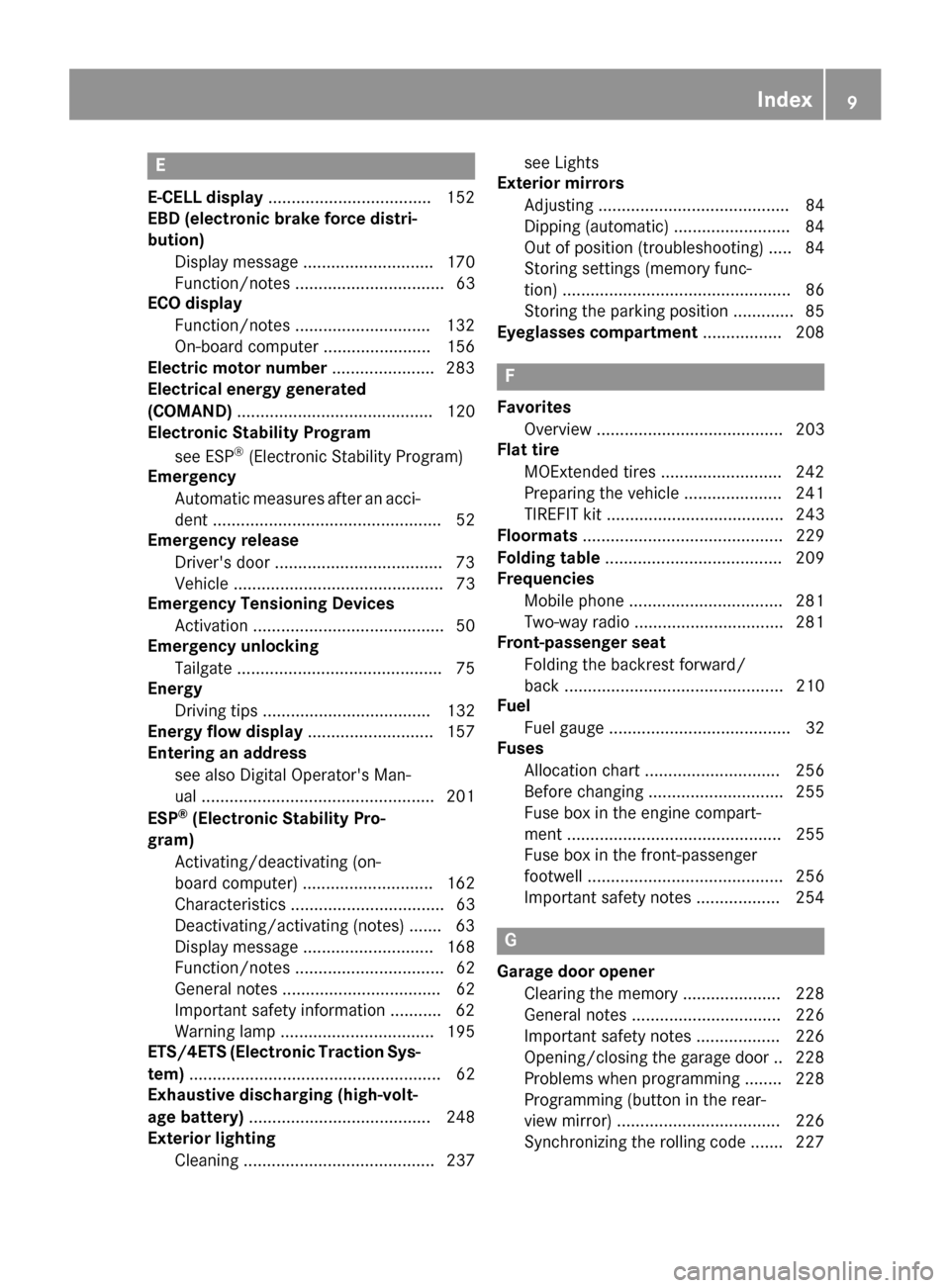
E
E ‑CELL display .................................. .152
EBD (electronic brake force distri-
bution)
Display message ............................ 170
Function/notes ................................ 63
ECO display
Function/notes ............................ .132
On-board computer ....................... 156
Electric motor number ......................283
Electrical energy generated
(COMAND) .......................................... 120
Electronic Stability Program
see ESP ®
(Electronic Stability Program)
Emergency
Automatic measures after an acci-
dent ................................................. 52
Emergency release
Driver's door ................................... .73
Vehicle .............................................73
Emergency Tensioning Devices
Activation ........................................ .50
Emergency unlocking
Tailgat e............................................ 75
Energy
Driving tips .................................... 132
Energy flow display ........................... 157
Entering an address
see also Digital Operator's Man-
ual.................................................. 201
ESP ®
(Electronic Stability Pro-
gram)
Activating/deactivating (on-
board computer) ............................ 162
Characteristics ................................. 63
Deactivating/activating (notes) ....... 63
Display message ............................ 168
Function/note s................................ 62
General notes .................................. 62
Important safety information ........... 62
Warning lamp ................................. 195
ETS/4ETS (Electronic Traction Sys-
tem) ...................................................... 62
Exhaustive discharging (high-volt-
age battery) ....................................... 248
Exterior lighting
Cleaning ......................................... 237 see Lights
Exterior mirrors
Adjusting ......................................... 84
Dipping (automatic) ......................... 84
Out of position (troubleshooting) ..... 84
Storing settings (memory func-
tion) ................................................. 86
Storing the parking position ............. 85
Eyeglasses compartment ................. 208 F
Favorites Overview ........................................ 203
Flat tire
MOExtended tire s.......................... 242
Preparing the vehicle ..................... 241
TIREFIT kit ...................................... 243
Floormats ........................................... 229
Folding table ...................................... 209
Frequencies
Mobile phone ................................. 281
Two-way radio ................................ 281
Front-passenger seat
Folding the backrest forward/
back ............................................... 210
Fuel
Fuel gaug e....................................... 32
Fuses
Allocation chart ............................. 256
Before changing ............................. 255
Fuse box in the engine compart-
ment .............................................. 255
Fuse box in the front-passenger
footwell .......................................... 256
Important safety notes .................. 254 G
Garage door opener Clearing the memory ..................... 228
General notes ................................ 226
Important safety notes .................. 226
Opening/closing the garage doo r..2 28
Problems when programming ....... .228
Programming (button in the rear-
view mirror) ................................... 226
Synchronizing the rolling code ....... 227 Index
9
Page 15 of 290
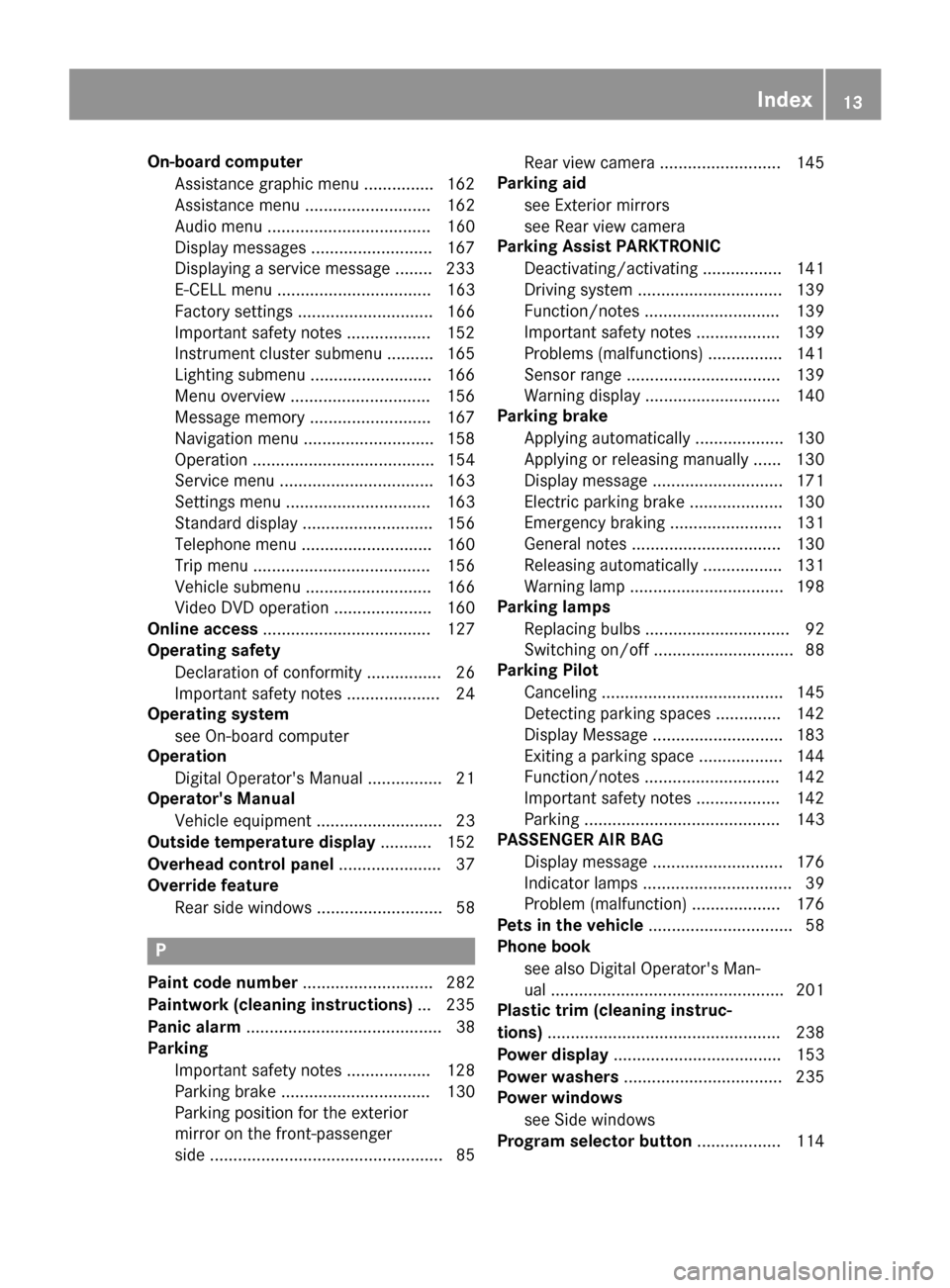
On-board computer
Assistance graphic menu ............... 162
Assistance menu ........................... 162
Audio menu ................................... 160
Display messages .......................... 167
Displaying a service message ........ 233
E‑CELL menu ................................. 163
Factory settings ............................. 166
Important safety notes .................. 152
Instrument cluster submenu ..........1 65
Lighting submenu .......................... 166
Menu overview .............................. 156
Message memory .......................... 167
Navigation menu ............................ 158
Operation ....................................... 154
Service menu ................................. 163
Settings menu ............................... 163
Standard displa y............................ 156
Telephone menu ............................ 160
Trip menu ...................................... 156
Vehicle submenu ........................... 166
Video DVD operation ..................... 160
Online access .................................... 127
Operating safety
Declaration of conformity ................ 26
Important safety notes .................... 24
Operating system
see On-board computer
Operation
Digital Operator's Manua l................ 21
Operator's Manual
Vehicle equipment ........................... 23
Outside temperature display ........... 152
Overhead control panel ...................... 37
Override feature
Rear side window s........................... 58 P
Paint code number ............................ 282
Paintwork (cleaning instructions) ... 235
Panic alarm .......................................... 38
Parking
Important safety notes .................. 128
Parking brake ................................ 130
Parking position for the exterior
mirror on the front-passenger
side .................................................. 85 Rear view camera .......................... 145
Parking aid
see Exterior mirrors
see Rear view camera
Parking Assist PARKTRONIC
Deactivating/activating ................. 141
Driving system ............................... 139
Function/note s............................. 139
Important safety notes .................. 139
Problems (malfunctions) ................ 141
Sensor rang e................................. 139
Warning display ............................. 140
Parking brake
Applying automaticall y................... 130
Applying or releasing manually ...... 130
Display message ............................ 171
Electric parking brake .................... 130
Emergency braking ........................ 131
General notes ................................ 130
Releasing automaticall y................. 131
Warning lamp ................................. 198
Parking lamps
Replacing bulb s............................... 92
Switching on/of f.............................. 88
Parking Pilot
Canceling ....................................... 145
Detecting parking spaces .............. 142
Display Message ............................ 183
Exiting a parking space .................. 144
Function/note s............................. 142
Important safety notes .................. 142
Parking .......................................... 143
PASSENGER AIR BAG
Display message ............................ 176
Indicator lamps ................................ 39
Problem (malfunction) ................... 176
Pets in the vehicle ............................... 58
Phone book
see also Digital Operator's Man-
ual .................................................. 201
Plastic trim (cleaning instruc-
tions) .................................................. 238
Power display .................................... 153
Power washers .................................. 235
Power windows
see Side windows
Program selector button .................. 114 Index
13
Page 17 of 290
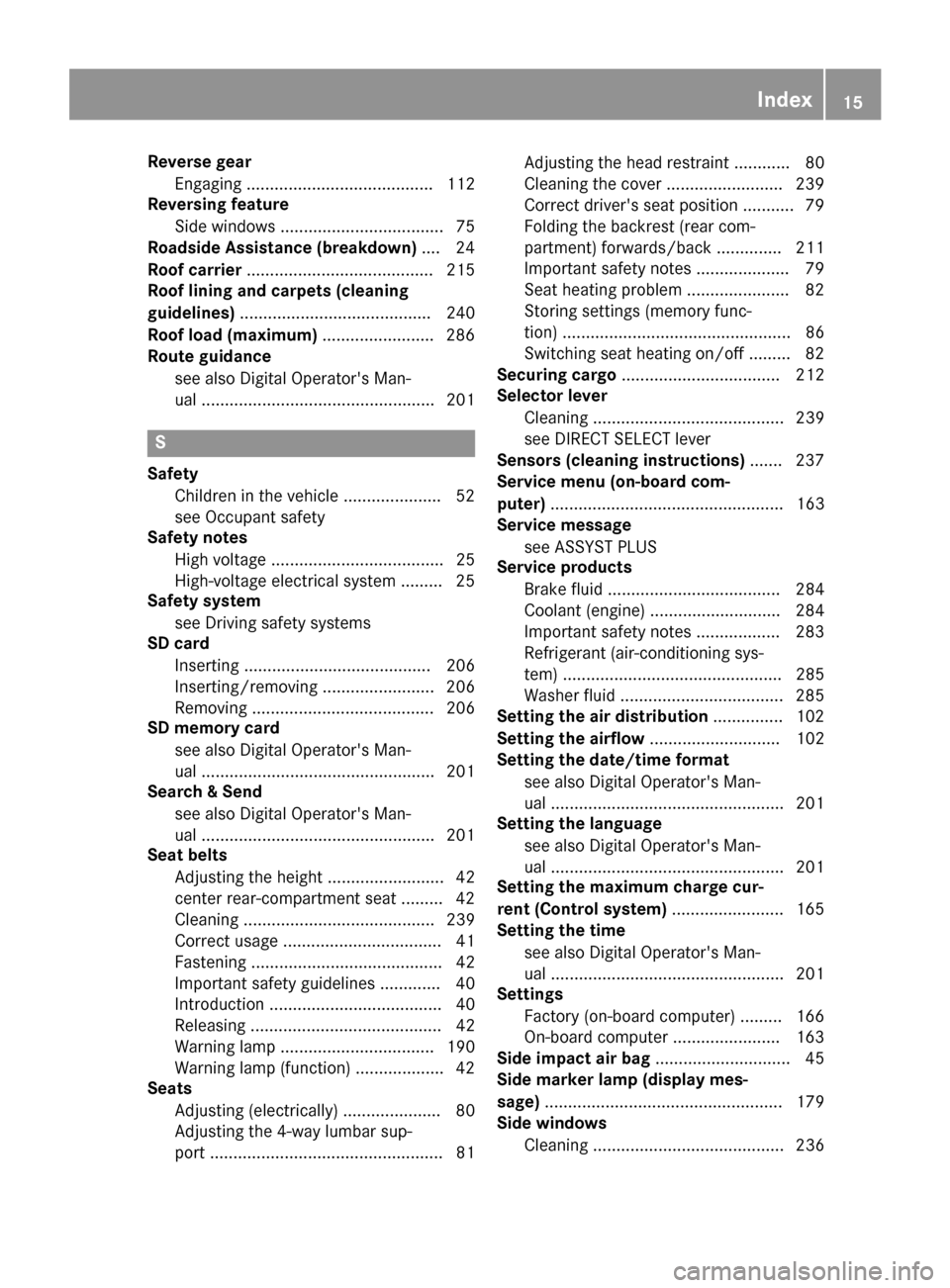
Reverse gear
Engaging ........................................ 112
Reversing feature
Side windows ................................... 75
Roadside Assistance (breakdown) .... 24
Roof carrier ........................................ 215
Roof lining and carpets (cleaning
guidelines) ......................................... 240
Roof load (maximum) ........................ 286
Route guidance
see also Digital Operator's Man-
ual .................................................. 201 S
Safety Children in the vehicle ..................... 52
see Occupant safety
Safety notes
High voltage ..................................... 25
High-voltage electrical system ......... 25
Safety system
see Driving safety systems
SD card
Inserting ........................................ 206
Inserting/removing ........................ 206
Removing ....................................... 206
SD memory card
see also Digital Operator's Man-
ual .................................................. 201
Search & Send
see also Digital Operator's Man-
ual .................................................. 201
Seat belts
Adjusting the height ......................... 42
center rear-compartment sea t......... 42
Cleaning ......................................... 239
Correct usage .................................. 41
Fastening ......................................... 42
Important safety guidelines ............. 40
Introduction ..................................... 40
Releasing ......................................... 42
Warning lamp ................................. 190
Warning lamp (function) ................... 42
Seats
Adjusting (electrically) ..................... 80
Adjusting the 4-way lumbar sup-
port .................................................. 81 Adjusting the head restraint ............ 80
Cleaning the cover ......................... 239
Correct driver's seat position ........... 79
Folding the backrest (rear com-
partment) forwards/back .............. 211
Important safety notes .................... 79
Seat heating problem ...................... 82
Storing settings (memory func-
tion) ................................................. 86
Switching seat heating on/of f......... 82
Securing cargo .................................. 212
Selector lever
Cleaning ......................................... 239
see DIRECT SELECT lever
Sensors (cleaning instructions) ....... 237
Service menu (on-board com-
puter) .................................................. 163
Service message
see ASSYST PLUS
Service products
Brake fluid ..................................... 284
Coolant (engine) ............................ 284
Important safety notes .................. 283
Refrigerant (air-conditioning sys-
tem) ............................................... 285
Washer fluid ................................... 285
Setting the air distribution ............... 102
Setting the airflow ............................ 102
Setting the date/time format
see also Digital Operator's Man-
ual .................................................. 201
Setting the language
see also Digital Operator's Man-
ual .................................................. 201
Setting the maximum charge cur-
rent (Control system) ........................ 165
Setting the time
see also Digital Operator's Man-
ual .................................................. 201
Settings
Factory (on-board computer) ......... 166
On-board compute r....................... 163
Side impact air bag ............................. 45
Side marker lamp (display mes-
sage) ................................................... 179
Side windows
Cleaning ......................................... 236 Index
15
Page 24 of 290
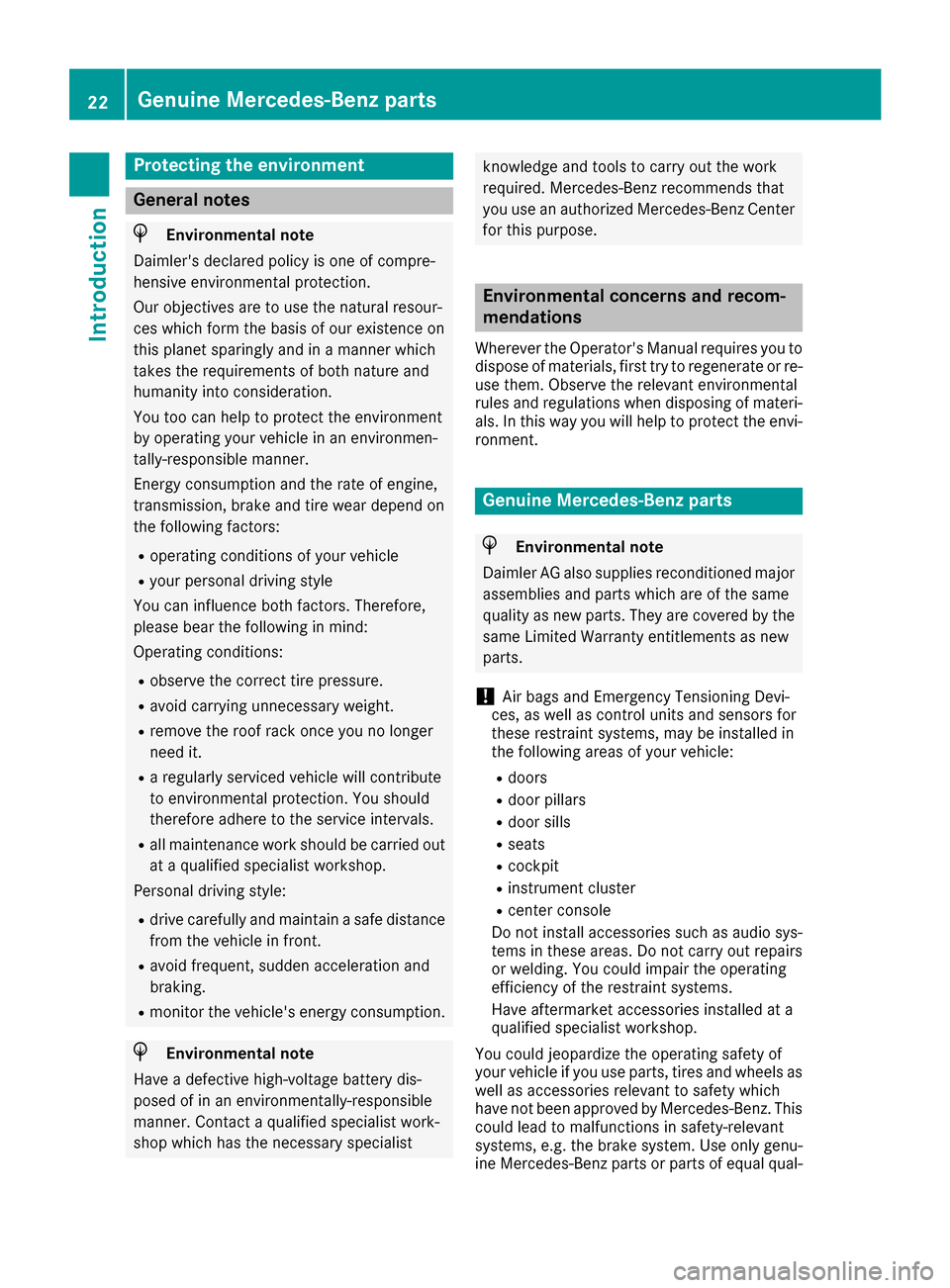
Protecting the environment
General notes
H
Environmental note
Daimler's declared policy is one of compre-
hensive environmental protection.
Our objectives are to use the natural resour-
ces which form the basis of our existence on
this planet sparingly and in a manner which
takes the requirements of both nature and
humanity into consideration.
You too can help to protect the environment
by operating your vehicle in an environmen-
tally-responsible manner.
Energy consumption and the rate of engine,
transmission, brake and tire wear depend on
the following factors:
R operating conditions of your vehicle
R your personal driving style
You can influence both factors. Therefore,
please bear the following in mind:
Operating conditions:
R observe the correct tire pressure.
R avoid carrying unnecessary weight.
R remove the roof rack once you no longer
need it.
R a regularly serviced vehicle will contribute
to environmental protection. You should
therefore adhere to the service intervals.
R all maintenance work should be carried out
at a qualified specialist workshop.
Personal driving style:
R drive carefully and maintain a safe distance
from the vehicle in front.
R avoid frequent, sudden acceleration and
braking.
R monitor the vehicle's energy consumption. H
Environmental note
Have a defective high-voltage battery dis-
posed of in an environmentally-responsible
manner. Contact a qualified specialist work-
shop which has the necessary specialist knowledge and tools to carry out the work
required. Mercedes-Benz recommends that
you use an authorized Mercedes-Benz Center for this purpose. Environmental concerns and recom-
mendations
Wherever the Operator's Manual requires you to dispose of materials, first try to regenerate or re-use them. Observe the relevant environmental
rules and regulations when disposing of materi-
als. In this way you will help to protect the envi-
ronment. Genuine Mercedes-Benz parts
H
Environmental note
Daimler AG also supplies reconditioned major
assemblies and parts which are of the same
quality as new parts. They are covered by the same Limited Warranty entitlements as new
parts.
! Air bags and Emergency Tensioning Devi-
ces, as well as control units and sensors for
these restraint systems, may be installed in
the following areas of your vehicle:
R doors
R door pillars
R door sills
R seats
R cockpit
R instrument cluster
R center console
Do not install accessories such as audio sys-
tems in these areas. Do not carry out repairs or welding. You could impair the operating
efficiency of the restraint systems.
Have aftermarket accessories installed at a
qualified specialist workshop.
You could jeopardize the operating safety of
your vehicle if you use parts, tires and wheels as well as accessories relevant to safety which
have not been approved by Mercedes-Benz. This
could lead to malfunctions in safety-relevant
systems, e.g. the brake system. Use only genu-
ine Mercedes-Benz parts or parts of equal qual- 22
Genuine Mercedes-Benz partsIntroduction
Page 25 of 290
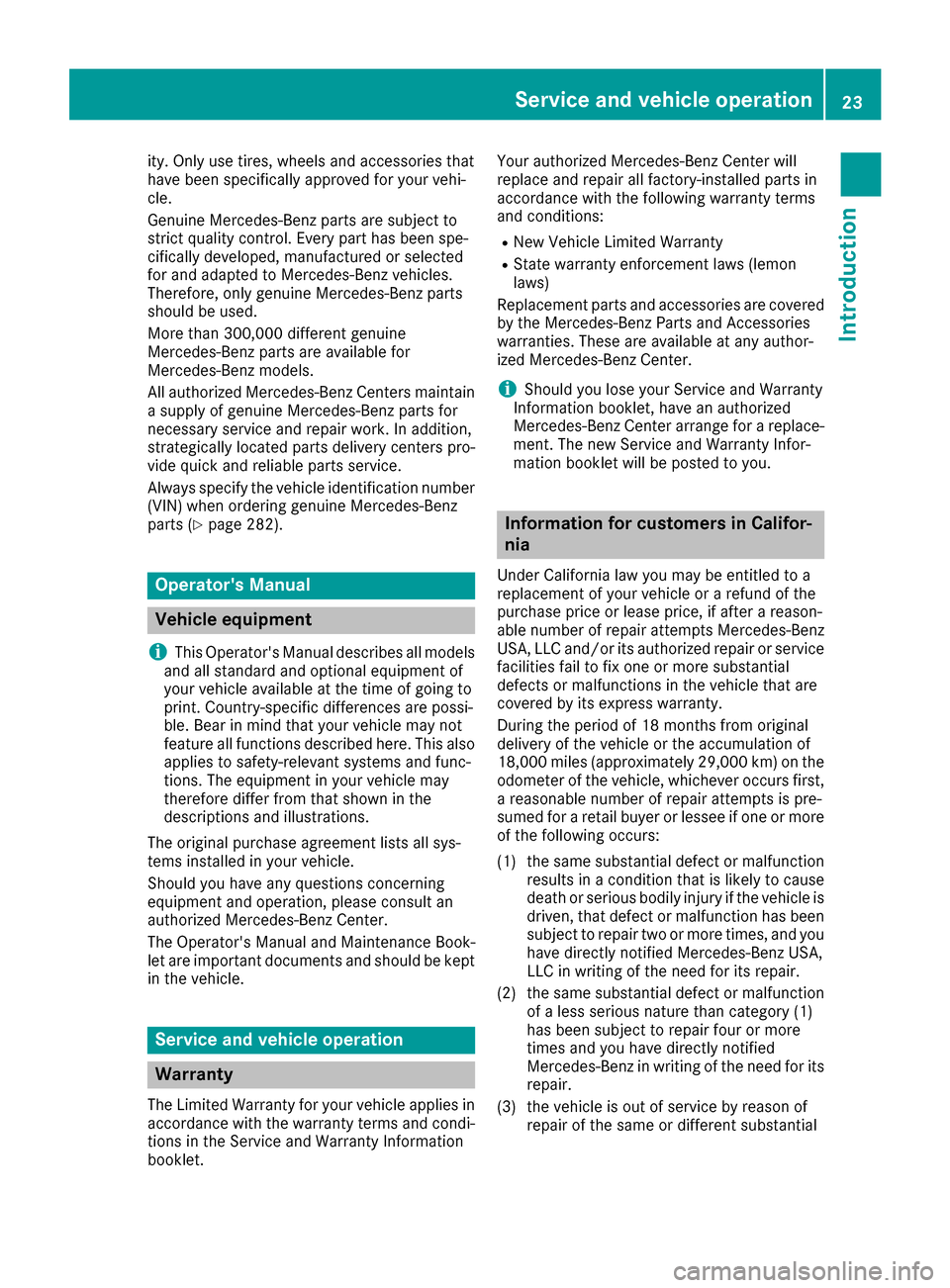
ity. Only use tires, wheels and accessories that
have been specifically approved for your vehi-
cle.
Genuine Mercedes-Benz parts are subject to
strict quality control. Every part has been spe-
cifically developed, manufactured or selected
for and adapted to Mercedes-Benz vehicles.
Therefore, only genuine Mercedes-Benz parts
should be used.
More than 300,000 different genuine
Mercedes-Benz parts are available for
Mercedes-Benz models.
All authorized Mercedes-Benz Centers maintain
a supply of genuine Mercedes-Benz parts for
necessary service and repair work. In addition,
strategically located parts delivery centers pro-
vide quick and reliable parts service.
Always specify the vehicle identification number (VIN) when ordering genuine Mercedes-Benz
parts (Y page 282). Operator's Manual
Vehicle equipment
i This Operator's Manual describes all models
and all standard and optional equipment of
your vehicle available at the time of going to
print. Country-specific differences are possi-
ble. Bear in mind that your vehicle may not
feature all functions described here. This also
applies to safety-relevant systems and func-
tions. The equipment in your vehicle may
therefore differ from that shown in the
descriptions and illustrations.
The original purchase agreement lists all sys-
tems installed in your vehicle.
Should you have any questions concerning
equipment and operation, please consult an
authorized Mercedes-Benz Center.
The Operator's Manual and Maintenance Book-
let are important documents and should be kept
in the vehicle. Service and vehicle operation
Warranty
The Limited Warranty for your vehicle applies in
accordance with the warranty terms and condi-
tions in the Service and Warranty Information
booklet. Your authorized Mercedes-Benz Center will
replace and repair all factory-installed parts in
accordance with the following warranty terms
and conditions:
R New Vehicle Limited Warranty
R State warranty enforcement laws (lemon
laws)
Replacement parts and accessories are covered
by the Mercedes-Benz Parts and Accessories
warranties. These are available at any author-
ized Mercedes-Benz Center.
i Should you lose your Service and Warranty
Information booklet, have an authorized
Mercedes-Benz Center arrange for a replace-
ment. The new Service and Warranty Infor-
mation booklet will be posted to you. Information for customers in Califor-
nia
Under California law you may be entitled to a
replacement of your vehicle or a refund of the
purchase price or lease price, if after a reason-
able number of repair attempts Mercedes-Benz USA, LLC and/or its authorized repair or servicefacilities fail to fix one or more substantial
defects or malfunctions in the vehicle that are
covered by its express warranty.
During the period of 18 months from original
delivery of the vehicle or the accumulation of
18,000 miles (approximately 29,000 km) on the
odometer of the vehicle, whichever occurs first,
a reasonable number of repair attempts is pre-
sumed for a retail buyer or lessee if one or more of the following occurs:
(1) the same substantial defect or malfunction results in a condition that is likely to cause
death or serious bodily injury if the vehicle is
driven, that defect or malfunction has been subject to repair two or more times, and youhave directly notified Mercedes-Benz USA,
LLC in writing of the need for its repair.
(2) the same substantial defect or malfunction of a less serious nature than category (1)
has been subject to repair four or more
times and you have directly notified
Mercedes-Benz in writing of the need for its
repair.
(3) the vehicle is out of service by reason of repair of the same or different substantial Service and vehicle operation
23Introduction Z
Page 26 of 290
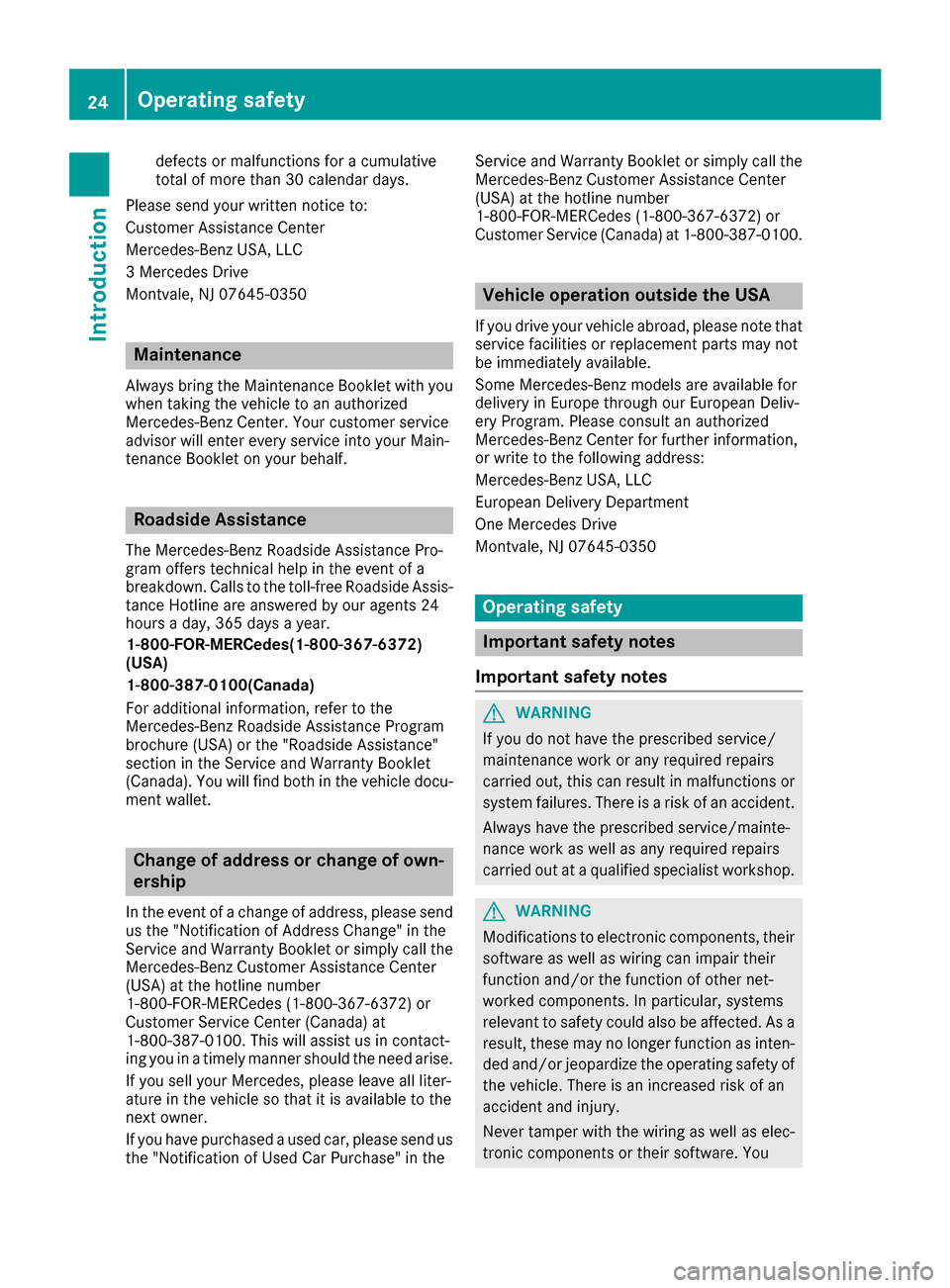
defects or malfunctions for a cumulative
total of more than 30 calendar days.
Please send your written notice to:
Customer Assistance Center
Mercedes-Benz USA, LLC
3 Mercedes Drive
Montvale, NJ 07645-0350 Maintenance
Always bring the Maintenance Booklet with you
when taking the vehicle to an authorized
Mercedes-Benz Center. Your customer service
advisor will enter every service into your Main-
tenance Booklet on your behalf. Roadside Assistance
The Mercedes-Benz Roadside Assistance Pro-
gram offers technical help in the event of a
breakdown. Calls to the toll-free Roadside Assis- tance Hotline are answered by our agents 24
hours a day, 365 days a year.
1-800-FOR-MERCedes(1-800-367-6372)
(USA)
1-800-387-0100(Canada)
For additional information, refer to the
Mercedes-Benz Roadside Assistance Program
brochure (USA) or the "Roadside Assistance"
section in the Service and Warranty Booklet
(Canada). You will find both in the vehicle docu-
ment wallet. Change of address or change of own-
ership
In the event of a change of address, please send
us the "Notification of Address Change" in the
Service and Warranty Booklet or simply call the Mercedes-Benz Customer Assistance Center
(USA) at the hotline number
1-800-FOR-MERCedes (1-800-367-6372) or
Customer Service Center (Canada) at
1-800-387-0100. This will assist us in contact-
ing you in a timely manner should the need arise.
If you sell your Mercedes, please leave all liter-
ature in the vehicle so that it is available to the
next owner.
If you have purchased a used car, please send us the "Notification of Used Car Purchase" in the Service and Warranty Booklet or simply call the
Mercedes-Benz Customer Assistance Center
(USA) at the hotline number
1-800-FOR-MERCedes (1-800-367-6372) or
Customer Service (Canada) at 1-800-387-0100. Vehicle operation outside the USA
If you drive your vehicle abroad, please note that
service facilities or replacement parts may not
be immediately available.
Some Mercedes-Benz models are available for
delivery in Europe through our European Deliv-
ery Program. Please consult an authorized
Mercedes-Benz Center for further information,
or write to the following address:
Mercedes-Benz USA, LLC
European Delivery Department
One Mercedes Drive
Montvale, NJ 07645-0350 Operating safety
Important safety notes
Important safety notes G
WARNING
If you do not have the prescribed service/
maintenance work or any required repairs
carried out, this can result in malfunctions or system failures. There is a risk of an accident.
Always have the prescribed service/mainte-
nance work as well as any required repairs
carried out at a qualified specialist workshop. G
WARNING
Modifications to electronic components, their software as well as wiring can impair their
function and/or the function of other net-
worked components. In particular, systems
relevant to safety could also be affected. As a
result, these may no longer function as inten-
ded and/or jeopardize the operating safety of
the vehicle. There is an increased risk of an
accident and injury.
Never tamper with the wiring as well as elec-
tronic components or their software. You 24
Operating safetyIntroduction
Page 28 of 290
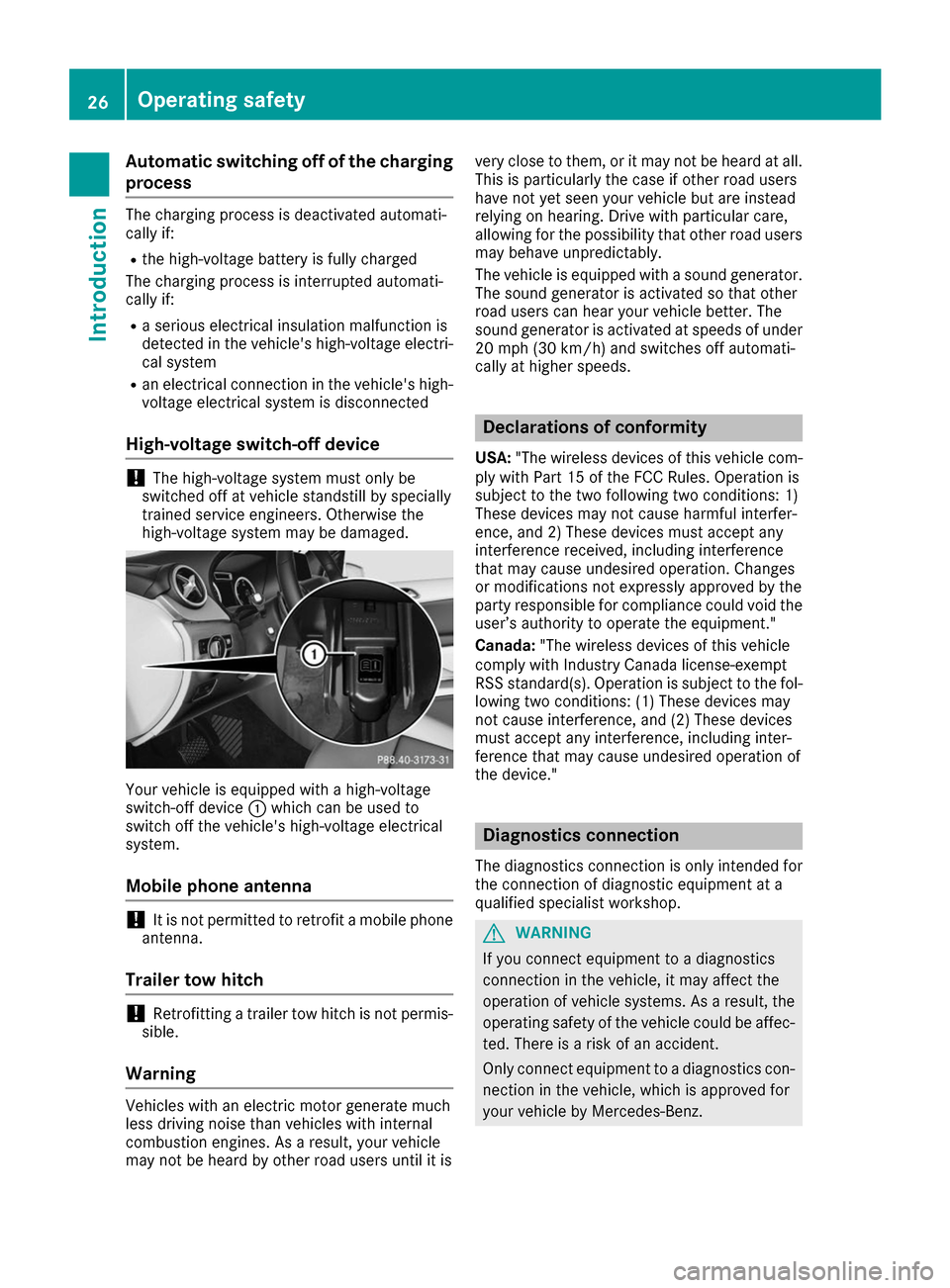
Automatic switching off of the charging
process The charging process is deactivated automati-
cally if:
R the high-voltage battery is fully charged
The charging process is interrupted automati-
cally if:
R a serious electrical insulation malfunction is
detected in the vehicle's high-voltage electri- cal system
R an electrical connection in the vehicle's high-
voltage electrical system is disconnected
High-voltage switch-off device !
The high-voltage system must only be
switched off at vehicle standstill by specially
trained service engineers. Otherwise the
high-voltage system may be damaged. Your vehicle is equipped with a high-voltage
switch-off device 0043which can be used to
switch off the vehicle's high-voltage electrical
system.
Mobile phone antenna !
It is not permitted to retrofit a mobile phone
antenna.
Trailer tow hitch !
Retrofitting a trailer tow hitch is not permis-
sible.
Warning Vehicles with an electric motor generate much
less driving noise than vehicles with internal
combustion engines. As a result, your vehicle
may not be heard by other road users until it is very close to them, or it may not be heard at all.
This is particularly the case if other road users
have not yet seen your vehicle but are instead
relying on hearing. Drive with particular care,
allowing for the possibility that other road users may behave unpredictably.
The vehicle is equipped with a sound generator.
The sound generator is activated so that other
road users can hear your vehicle better. The
sound generator is activated at speeds of under
20 mph (30 km/ h)and switches off automati-
cally at higher speeds. Declarations of conformity
USA: "The wireless devices of this vehicle com-
ply with Part 15 of the FCC Rules. Operation is
subject to the two following two conditions: 1)
These devices may not cause harmful interfer-
ence, and 2) These devices must accept any
interference received, including interference
that may cause undesired operation. Changes
or modifications not expressly approved by the
party responsible for compliance could void the
user’s authority to operate the equipment."
Canada: "The wireless devices of this vehicle
comply with Industry Canada license-exempt
RSS standard(s). Operation is subject to the fol-
lowing two conditions: (1) These devices may
not cause interference, and (2) These devices
must accept any interference, including inter-
ference that may cause undesired operation of
the device." Diagnostics connection
The diagnostics connection is only intended for
the connection of diagnostic equipment at a
qualified specialist workshop. G
WARNING
If you connect equipment to a diagnostics
connection in the vehicle, it may affect the
operation of vehicle systems. As a result, the operating safety of the vehicle could be affec-
ted. There is a risk of an accident.
Only connect equipment to a diagnostics con-
nection in the vehicle, which is approved for
your vehicle by Mercedes-Benz. 26
Operating safetyIntroduction
Page 29 of 290
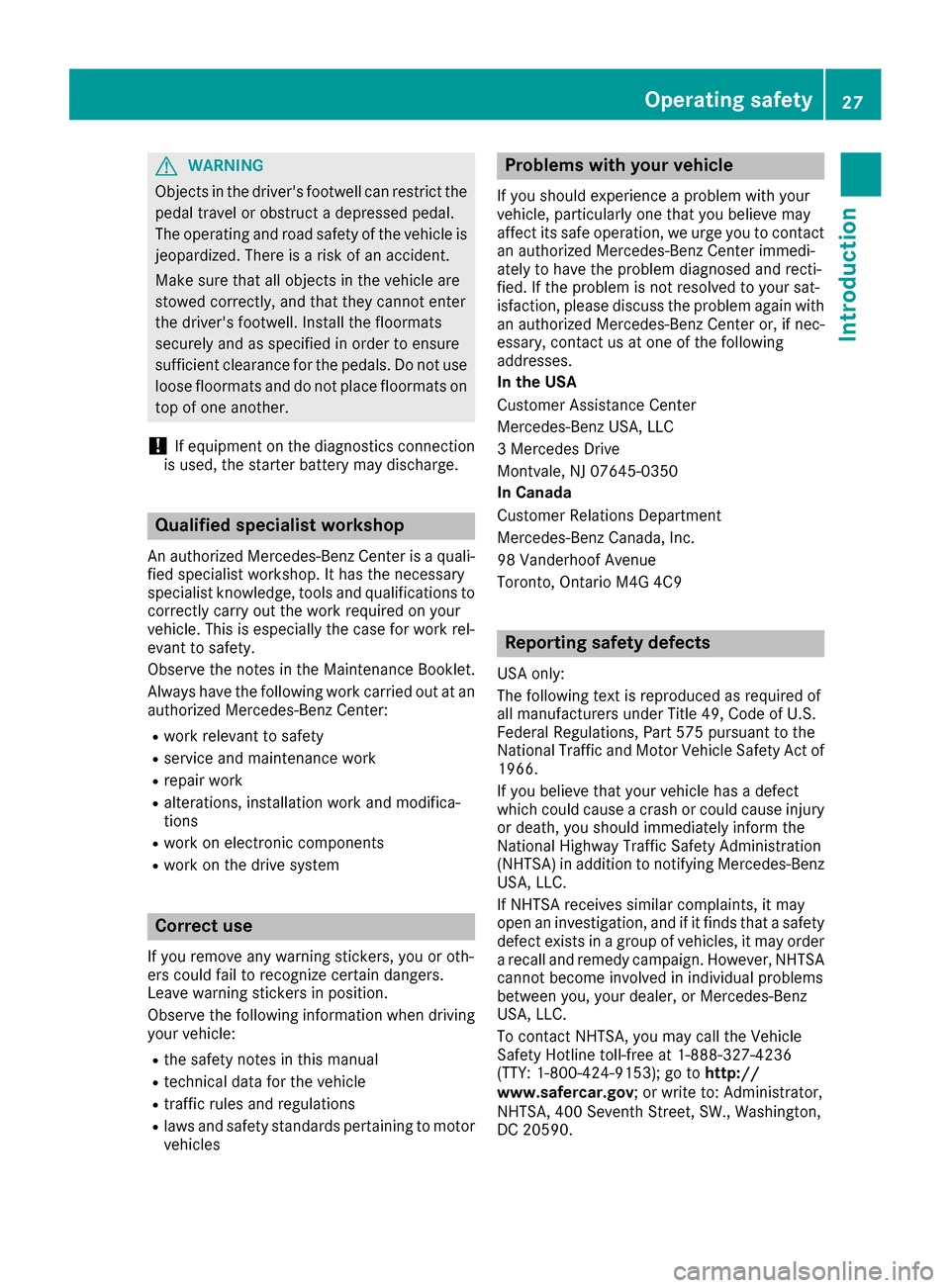
G
WARNING
Objects in the driver's footwell can restrict the pedal travel or obstruct a depressed pedal.
The operating and road safety of the vehicle is
jeopardized. There is a risk of an accident.
Make sure that all objects in the vehicle are
stowed correctly, and that they cannot enter
the driver's footwell. Install the floormats
securely and as specified in order to ensure
sufficient clearance for the pedals. Do not use loose floormats and do not place floormats on
top of one another.
! If equipment on the diagnostics connection
is used, the starter battery may discharge. Qualified specialist workshop
An authorized Mercedes-Benz Center is a quali-
fied specialist workshop. It has the necessary
specialist knowledge, tools and qualifications to correctly carry out the work required on your
vehicle. This is especially the case for work rel-
evant to safety.
Observe the notes in the Maintenance Booklet.
Always have the following work carried out at an authorized Mercedes-Benz Center:
R work relevant to safety
R service and maintenance work
R repair work
R alterations, installation work and modifica-
tions
R work on electronic components
R work on the drive system Correct use
If you remove any warning stickers, you or oth-
ers could fail to recognize certain dangers.
Leave warning stickers in position.
Observe the following information when driving your vehicle:
R the safety notes in this manual
R technical data for the vehicle
R traffic rules and regulations
R laws and safety standards pertaining to motor
vehicles Problems with your vehicle
If you should experience a problem with your
vehicle, particularly one that you believe may
affect its safe operation, we urge you to contact
an authorized Mercedes-Benz Center immedi-
ately to have the problem diagnosed and recti-
fied. If the problem is not resolved to your sat-
isfaction, please discuss the problem again with
an authorized Mercedes-Benz Center or, if nec-
essary, contact us at one of the following
addresses.
In the USA
Customer Assistance Center
Mercedes-Benz USA, LLC
3 Mercedes Drive
Montvale, NJ 07645-0350
In Canada
Customer Relations Department
Mercedes-Benz Canada, Inc.
98 Vanderhoof Avenue
Toronto, Ontario M4G 4C9 Reporting safety defects
USA only:
The following text is reproduced as required of
all manufacturers under Title 49, Code of U.S.
Federal Regulations, Part 575 pursuant to the
National Traffic and Motor Vehicle Safety Act of 1966.
If you believe that your vehicle has a defect
which could cause a crash or could cause injury
or death, you should immediately inform the
National Highway Traffic Safety Administration
(NHTSA) in addition to notifying Mercedes-Benz USA, LLC.
If NHTSA receives similar complaints, it may
open an investigation, and if it finds that a safety
defect exists in a group of vehicles, it may order a recall and remedy campaign. However, NHTSA
cannot become involved in individual problems
between you, your dealer, or Mercedes-Benz
USA, LLC.
To contact NHTSA, you may call the Vehicle
Safety Hotline toll-free at 1-888-327-4236
(TTY: 1-800-424-9153); go to http://
www.safercar.gov; or write to: Administrator,
NHTSA, 400 Seventh Street, SW., Washington,
DC 20590. Operating safety
27Introduction Z
Page 44 of 290

Seat belts are only intended to secure and
restrain vehicle occupants. Always observe the
"Loading guidelines" for securing objects, lug-
gage or loads (Y page 207).
Fastening and adjusting the seat belts Observe the safety notes on the seat belt
(Y
page 40 )and the notes on correct use of seat
belts (Y page 41).
If the center rear seat belt is being used, also
observe the information about the seat belt for
the center rear seat (Y page 42).Basic illustration
X Adjust the seat (Y page 79).
The seat backrest must be in an almost ver-
tical position.
X Pull the seat belt smoothly from the belt out-
let.
X Engage seat belt tongue 0044in belt buckle 0043.
X If necessary, pull upwards on the shoulder
section of the seat belt to tighten the belt
across your body.
The shoulder section of the seat belt must
always be routed across the center of the shoul- der. Adjust the belt outlet if necessary.
X To raise: slide the belt outlet upwards.
The belt outlet will engage in various posi-
tions.
X To lower: hold belt outlet release 0087and slide
belt outlet downwards.
X Let go of belt outlet release 0087in the desired
position and make sure that the belt outlet
engages.
All seat belts except the driver's seat belt are
equipped with a special seat belt retractor to
securely fasten child restraint systems in the
vehicle. Further information can be found under "Special seat belt retractor" (Y page 53).Seat belt for the center rear seat If the left-hand rear seat backrest is folded down
and back up again, the rear center seat belt may lock. The seat belt can then not be pulled out.
X To release the rear center seat belt: pull
the seat belt out approximately 1 in (25 mm)
at the belt outlet on the backrest and then
release it again.
The seat belt is retracted and released.
Releasing seat belts !
Make sure that the seat belt is fully rolled up.
Otherwise, the seat belt or belt tongue will be
trapped in the door or in the seat mechanism. This could damage the door, the door trim
panel and the seat belt. Damaged seat belts
can no longer fulfill their protective function
and must be replaced. Visit a qualified spe-
cialist workshop.
X Press the release button in the belt buckle,
hold the belt tongue firmly and guide the belt
back.
Belt warning for the driver and front
passenger The
0076 seat belt warning lamp in the instru-
ment cluster is a reminder that all vehicle occu- pants must wear their seat belts. It may light up
continuously or flash. In addition, there may be
a warning tone.
Regardless of whether the driver's seat belt has
already been fastened, the 0076seat belt warn-
ing lamp lights up for six seconds each time the
drive system is started. If the front doors are
closed and the driver or front-passenger seat
belt has not been fastened, the 0076seat belt
warning lamp lights up again after the
six seconds. As soon as the driver's and front-
passenger seat belts are fastened or a front door is opened again, the 0076seat belt warning
lamp goes out.
If the driver's seat belt is not fastened after the drive system is started, an additional warning
tone will sound. The warning tone switches off
after six seconds or once the driver's seat belt is
fastened.
If the vehicle's speed exceeds 15 mph
(25 km/h) once and the driver's and front-
passenger seat belts are not fastened, a warning
tone sounds. A warning tone also sounds with 42
Occupant safetySafety
Page 53 of 290
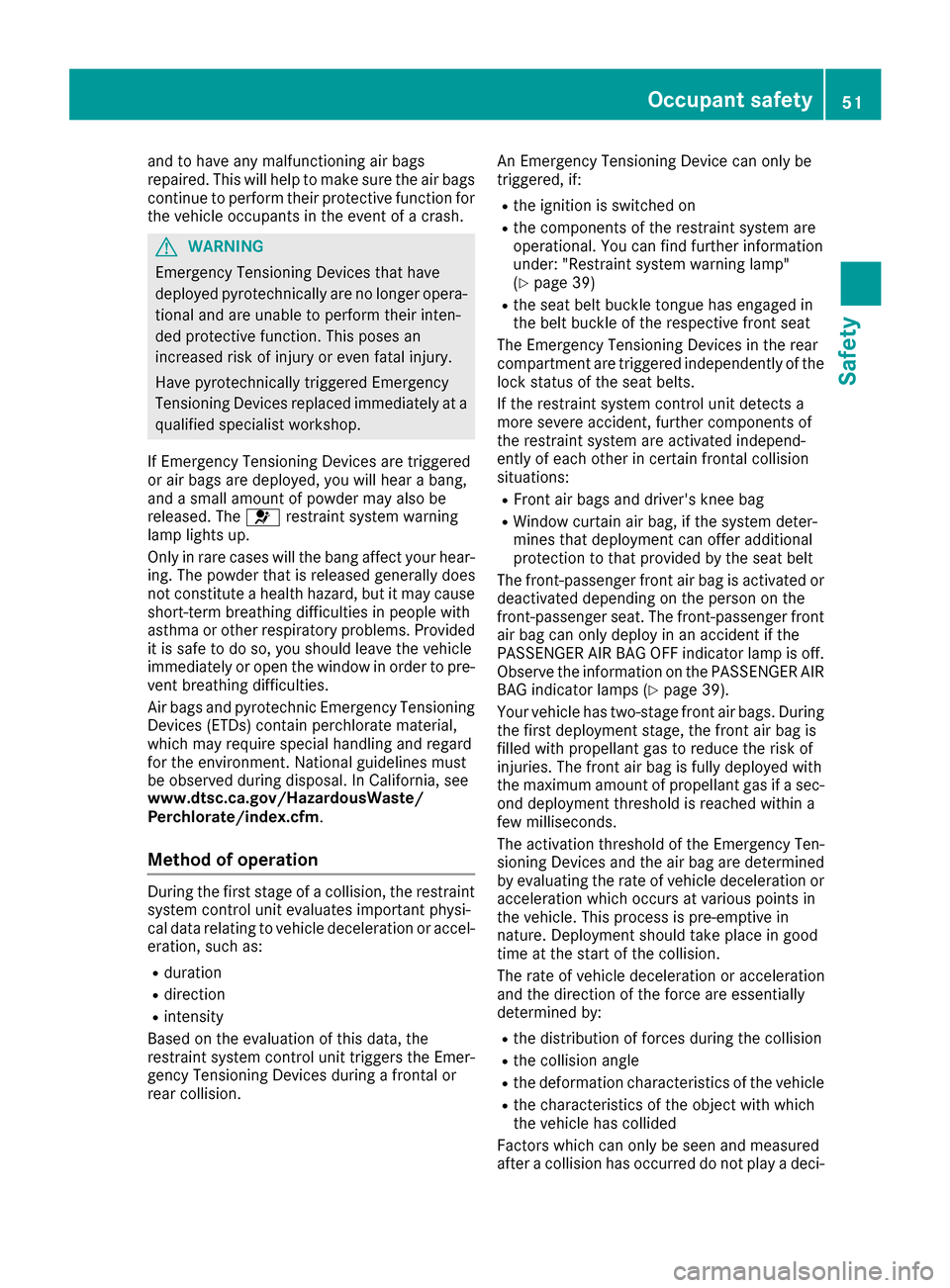
and to have any malfunctioning air bags
repaired. This will help to make sure the air bags
continue to perform their protective function for the vehicle occupants in the event of a crash. G
WARNING
Emergency Tensioning Devices that have
deployed pyrotechnically are no longer opera- tional and are unable to perform their inten-
ded protective function. This poses an
increased risk of injury or even fatal injury.
Have pyrotechnically triggered Emergency
Tensioning Devices replaced immediately at a qualified specialist workshop.
If Emergency Tensioning Devices are triggered
or air bags are deployed, you will hear a bang,
and a small amount of powder may also be
released. The 0075restraint system warning
lamp lights up.
Only in rare cases will the bang affect your hear-
ing. The powder that is released generally does
not constitute a health hazard, but it may cause
short-term breathing difficulties in people with
asthma or other respiratory problems. Provided it is safe to do so, you should leave the vehicle
immediately or open the window in order to pre- vent breathing difficulties.
Air bags and pyrotechnic Emergency Tensioning
Devices (ETDs) contain perchlorate material,
which may require special handling and regard
for the environment. National guidelines must
be observed during disposal. In California, see
www.dtsc.ca.gov/HazardousWaste/
Perchlorate/index.cfm .
Method of operation During the first stage of a collision, the restraint
system control unit evaluates important physi-
cal data relating to vehicle deceleration or accel-
eration, such as:
R duration
R direction
R intensity
Based on the evaluation of this data, the
restraint system control unit triggers the Emer-
gency Tensioning Devices during a frontal or
rear collision. An Emergency Tensioning Device can only be
triggered, if:
R the ignition is switched on
R the components of the restraint system are
operational. You can find further information
under: "Restraint system warning lamp"
(Y page 39)
R the seat belt buckle tongue has engaged in
the belt buckle of the respective front seat
The Emergency Tensioning Devices in the rear
compartment are triggered independently of the lock status of the seat belts.
If the restraint system control unit detects a
more severe accident, further components of
the restraint system are activated independ-
ently of each other in certain frontal collision
situations:
R Front air bags and driver's knee bag
R Window curtain air bag, if the system deter-
mines that deployment can offer additional
protection to that provided by the seat belt
The front-passenger front air bag is activated or deactivated depending on the person on the
front-passenger seat. The front-passenger front air bag can only deploy in an accident if the
PASSENGER AIR BAG OFF indicator lamp is off.
Observe the information on the PASSENGER AIR BAG indicator lamps (Y page 39).
Your vehicle has two-stage front air bags. During
the first deployment stage, the front air bag is
filled with propellant gas to reduce the risk of
injuries. The front air bag is fully deployed with
the maximum amount of propellant gas if a sec- ond deployment threshold is reached within a
few milliseconds.
The activation threshold of the Emergency Ten-
sioning Devices and the air bag are determined by evaluating the rate of vehicle deceleration or
acceleration which occurs at various points in
the vehicle. This process is pre-emptive in
nature. Deployment should take place in good
time at the start of the collision.
The rate of vehicle deceleration or acceleration
and the direction of the force are essentially
determined by:
R the distribution of forces during the collision
R the collision angle
R the deformation characteristics of the vehicle
R the characteristics of the object with which
the vehicle has collided
Factors which can only be seen and measured
after a collision has occurred do not play a deci- Occupant safety
51Safety Z